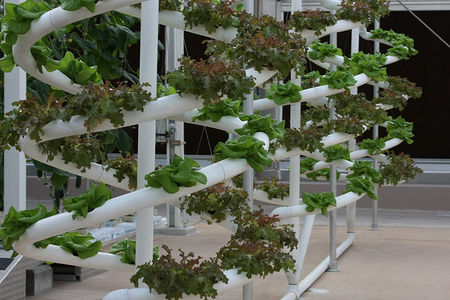Hydroponics: Difference between revisions
No edit summary |
No edit summary |
||
| Line 1: | Line 1: | ||
{{Category= | {{Category=Controlled-environment growing}} | ||
[[Image:Hydroponics.jpg|right|450px|thumb|An example of vertically stacked hydroponics. A system like this would allow a person to be self-sustaining for vegetables in just a few square meters. This makes it particularly useful for urban settings.]] | [[Image:Hydroponics.jpg|right|450px|thumb|An example of vertically stacked hydroponics. A system like this would allow a person to be self-sustaining for vegetables in just a few square meters. This makes it particularly useful for urban settings.]] | ||
Revision as of 15:29, 12 February 2011
Main > Food and Agriculture > Controlled-environment growing
Hydroponics is the practice of growing plants in nutrient-enriched water rather than soil.
Hydroponics is incredibly productive and requires little space. For example, Factor e Farm's experiments found that they could grow $1 of lettuce per square foot per week. And the Institute of Simplified Hydroponics has found that they can grow 2kg of vegetables a day on 20m2 of space [1]. Indoor growing in a greenhouse greatly reduces losses to pests.
See here for free instructions on building several different hydroponic systems. N55 have a design for a vertical hydroponic system here. See Wikipedia on hydroponics for more information.
Open source software for automating hydroponic systems.
Aquaponics is a kind of hydroponics that uses the water from fish tanks. This eliminates the need for an input of nutrients.
- Hydroponics - Everything You Need TO Know To Get Started, big messy 463-page book, covering everything: lighting, nutrients, suppliers, different plants and their requirements,
- How-To Hydroponics, 4th edition, a compact, practical book including plans for several systems
- http://www.hydroponicsonline.com/ An informative site. Also has forums.
